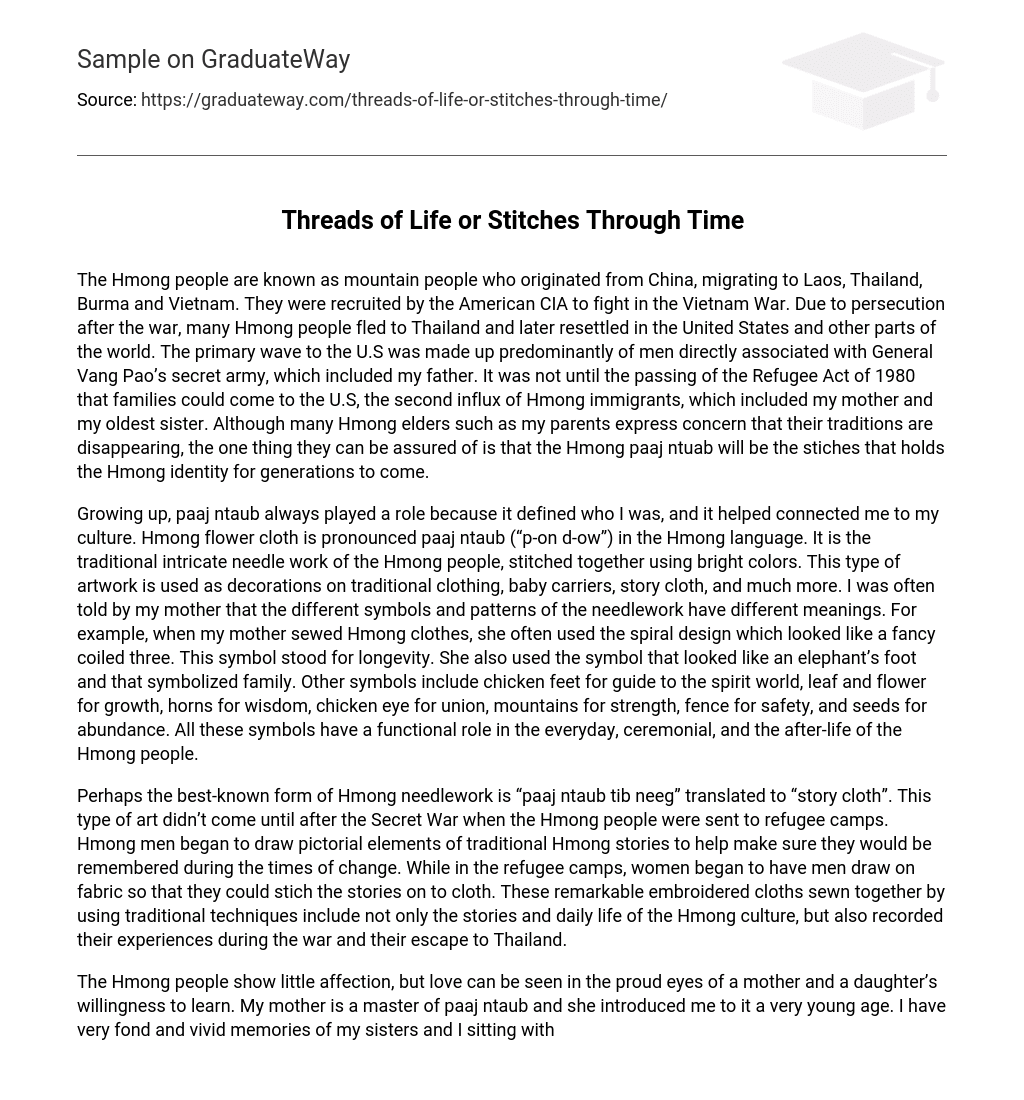The Hmong people are known as mountain people who originated from China, migrating to Laos, Thailand, Burma and Vietnam. They were recruited by the American CIA to fight in the Vietnam War. Due to persecution after the war, many Hmong people fled to Thailand and later resettled in the United States and other parts of the world. The primary wave to the U.S was made up predominantly of men directly associated with General Vang Pao’s secret army, which included my father. It was not until the passing of the Refugee Act of 1980 that families could come to the U.S, the second influx of Hmong immigrants, which included my mother and my oldest sister. Although many Hmong elders such as my parents express concern that their traditions are disappearing, the one thing they can be assured of is that the Hmong paaj ntuab will be the stiches that holds the Hmong identity for generations to come.
Growing up, paaj ntaub always played a role because it defined who I was, and it helped connected me to my culture. Hmong flower cloth is pronounced paaj ntaub (“p-on d-ow”) in the Hmong language. It is the traditional intricate needle work of the Hmong people, stitched together using bright colors. This type of artwork is used as decorations on traditional clothing, baby carriers, story cloth, and much more. I was often told by my mother that the different symbols and patterns of the needlework have different meanings. For example, when my mother sewed Hmong clothes, she often used the spiral design which looked like a fancy coiled three. This symbol stood for longevity. She also used the symbol that looked like an elephant’s foot and that symbolized family. Other symbols include chicken feet for guide to the spirit world, leaf and flower for growth, horns for wisdom, chicken eye for union, mountains for strength, fence for safety, and seeds for abundance. All these symbols have a functional role in the everyday, ceremonial, and the after-life of the Hmong people.
Perhaps the best-known form of Hmong needlework is “paaj ntaub tib neeg” translated to “story cloth”. This type of art didn’t come until after the Secret War when the Hmong people were sent to refugee camps. Hmong men began to draw pictorial elements of traditional Hmong stories to help make sure they would be remembered during the times of change. While in the refugee camps, women began to have men draw on fabric so that they could stich the stories on to cloth. These remarkable embroidered cloths sewn together by using traditional techniques include not only the stories and daily life of the Hmong culture, but also recorded their experiences during the war and their escape to Thailand.
The Hmong people show little affection, but love can be seen in the proud eyes of a mother and a daughter’s willingness to learn. My mother is a master of paaj ntaub and she introduced me to it a very young age. I have very fond and vivid memories of my sisters and I sitting with my mother for hours on the weekends just making paaj ntaub. To get started, I would hold the needle with my left hand and hold the thread in the other. Next, I would moisten the end of the thread with one lick, so it was easier to insert through the eye of the needle and then pull through. Now I am ready for the movement of thread and needle embracing to the rhythm at the fingertips. Each stitch another depth and another step forward. Sewing between the fabric in hand felt calming. For the longest time, my mother only taught us how to make straight stitches.
After we accomplished that part, she taught us how to make knots and then how to cross-stitch different patterns. The next step would how to reverse applique, something I never picked up. I remember my mother telling stories over and over reflecting on memories from her youth back in Laos. Then she would go on and tell us how it was so much easier to get a hold of fabric and thread in the western world. In Laos, hemp fabric was made by extracting fibers from the stalks of plants, spinning them into threads and weaving them into cloth. The skills for this artwork could not be acquired easily. It would take me years and years before I completed a piece.
In today’s world, the art of paaj ntaub has become modernized. The older Hmong women still complete their work by hand, however, many of the younger generation have adopted and have made it easier. They
Though my mother is sad that she was not able to get her hands on any of her mother’s or great grandmother’s paaj ntaub, she is blessed to have five daughters who she can pass her work down to. From her mind, to her creative ideas, to her life, to her skills, it is all there and something I will cherish forever as a Hmong daughter.





